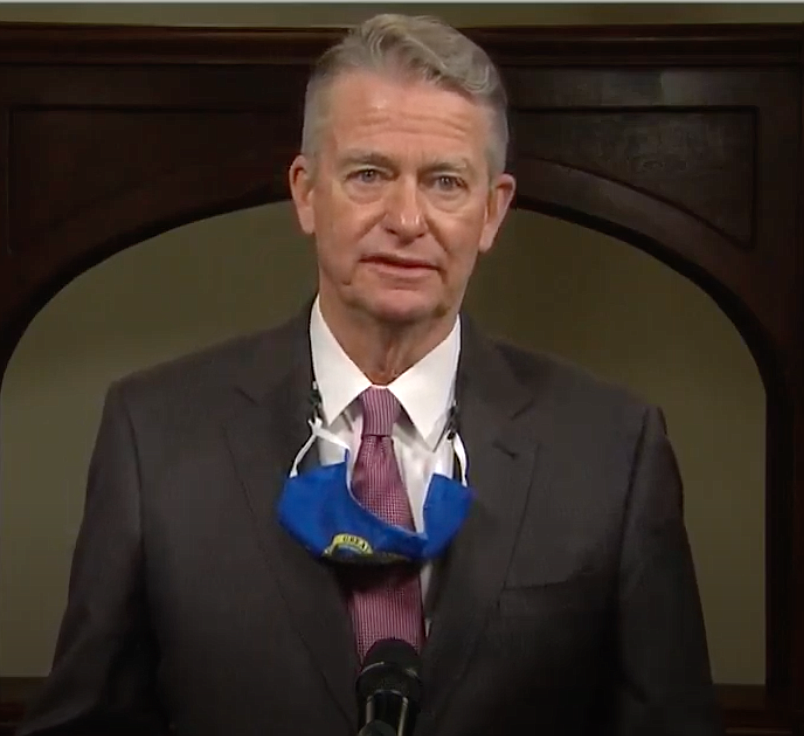Little limits gatherings, calls up Guard
Gov. Brad Little ordered Idaho to return to a modified Stage Two of his Idaho Rebounds plan Friday, limiting most indoor and outdoor gatherings to 10 people and under.
The move exempts places of worship and political assembly. Church services and protests may continue as scheduled, though social distancing is required statewide.
Little’s decision comes as COVID-19 continues to spread across Idaho. Wednesday’s 1,693 new cases shattered the state’s record of 1,403, set Nov. 7. Coronavirus numbers have steadfastly risen since mid-September in Idaho, as well as around the nation.
“With every day that passes we are breaking records in the number of COVID deaths, the number of overall hospitalizations and the number of new cases all across our state,” Little said at the virtual announcement.
Little’s original Stage Two order in mid-May opened many businesses from his original stay-home orders. Under that plan, bars and nightclubs were not able to open. Little’s Friday order did not close any businesses already open, bars and nightclubs included. Derrell Hartwick, CEO of the Coeur d’Alene Regional Chamber of Commerce, said he’s thankful Little chose to keep businesses open.
“I think (Little’s decision) shows he understands our business community and the needs and challenges it faces,” Hartwick said. “We’re No. 1 in the country right now for (an economic) rebound, but it’s important that the Coeur d’Alene region does whatever we can to keep our employees and customers safe.”
Despite the timing of the rise in cases since September, Little emphasized students were not widely transmitting the virus in classroom settings, adding that student participation in off-campus gatherings parties was more likely contributing to the rise. Scott Maben, director of communications for the Coeur d’Alene School District, said the district concurs.
“We agree that in-school transmission does not appear to be a major factor in overall community spread,” Maben said. “While it's difficult to know for sure when and how people contract the virus, to the best of our knowledge, fewer than one in five of our positive students and staff members were exposed at school. It would appear most people who test positive are being exposed at home or in other settings and gatherings outside of school. This makes sense, as the largest concentrations of people wearing masks during the day are students and teachers in our schools.”
Little’s policy does not apply to school-related activities, such as athletic events, which the district has already implemented an attendance cap.
“We certainly hope the move to Stage Two will help lower the community transmission rate and allow us to continue teaching students in person as much as we safely can,” Maben said. “The bigger concern continues to be the number of people in our community taking little or no precautions to stem the rising cases of COVID.”
The first-term governor also mobilized the National Guard Friday to assist the health care system. Little’s executive order called up 100 men and women from within the Guard to possibly assist in mobile testing support, COVID-19 screenings, decontamination and logistical planning.
Little cited the state’s precarious health care system — which he said was mere weeks away from rationing care for inbound patients — behind the decisions to limit gatherings and call up the National Guard.
“Our hospitals and other health care providers are telling us too many health care workers across Idaho are out sick with COVID, and they are contracting them within the community,” he said. “Doctors and nurses who are healthy are overworked and burned out. This is the biggest challenge facing health care right now: the availability of trained, heathy doctors and nurses to care for all patients, not just COVID patients.”
Little stopped short of issuing a statewide mask mandate but said the population’s lack of adherence to the Idaho Department of Health and Welfare’s recommendation to wear masks is troubling.
“Half of Idaho’s population is under a current local ordinance requiring masks,” he said, “but we are seeing non-compliance with these local orders. Or people wearing masks in public but taking them off in social settings, such as parties or other gatherings with friends, where the virus is more likely to spread."
Little pointed out that law enforcement has the ability to cite individuals for violating local ordinances but added that law enforcement can’t be everywhere at once, the reason behind his urgings for personal responsibility, rather than a statewide mask mandate.
“Please wear a mask when you’re around another person who’s not in your household,” Little said. “It will protect you and your loved ones. It will slow the COVID spread. It will keep people employed and protect our economy, and it will preserve health care access for all of us.”

